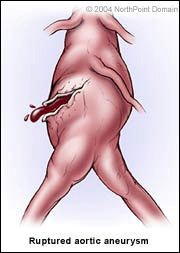What is an abdominal aortic aneurysm (AAA)?
An abdominal aortic aneurysm (AAA) is a balloon-like swelling of the aorta, which is the main blood vessel of the body. It is located in the middle of the abdomen behind the belly button. Famous people who have died from an AAA include Charles De Galle, Lucille Ball, George C. Scott, and Albert Einstein. Joe DiMaggio, Bob Uecker, and Senator Bob Dole survived their AAA’s.
The incidence of AAA is 5-10% of men over the age of 60 and 1-2% of women > 60. Extrapolated to current Vancouver Island population data, there are > 4020 AAA’s within the VIHA (Vancouver Island Health Authority) jurisdiction. Risk factors include age, male sex, family history of AAA’s, a history of atherosclerosis, and smoking. By far, the biggest risk factor is smoking, which increases your chance of forming an AAA up to 700% to 800% higher than a non-smoker.
What are the signs and symptoms of an AAA?
The only ways to find an AAA are through physical examination by your family doctor or with radiologic tests such as an X ray, ultrasound, MRI, or CT scan. Physical examination, unfortunately, is not very accurate in identifying all AAA’s (especially in patients who are not extremely thin). As a result, about half of all AAA’s are identified by chance during radiological investigations for other diseases.
AAA’s are generally not symptomatic and can grow silently within the abdomen. As the AAA grows larger, it will eventually burst causing sudden catastrophic bleeding and cardiovascular collapse. There may not be any outward signs that the AAA is even present until it ruptures. The mortality of a ruptured AAA is greater than 90%. Only a small fraction of patients will survive long enough to undergo an operation to repair the AAA. Unfortunately, only 50% of patients will survive an emergency operation to repair a ruptured AAA. Unless serious contraindications prohibit it, repair should be undertaken in all patients with a known aneurysm while it is still an elective procedure. Complication and mortality rates increase dramatically when an aneurysm ruptures and surgery becomes an emergency procedure.
What are the risks of leaving an AAA untreated?
 The natural history of AAA is progressive enlargement and eventual rupture (unless the patient dies of another cause). Risk of rupture is mainly determined by the maximum diameter of your AAA. Aneurysms smaller than 5.5 cm have a low annual risk of rupture of 1-2%. This means that the chance of rupturing an AAA <5.5 cm in the next 5 years is only about 5%. The threshold for operative intervention has been determined by two large studies reported in the New England Journal of Medicine in 2002. Based on these two studies, we are recommending surgery at a threshold of 5.5 cm for men and 5.0 cm for women provided they are good operative risk patients. The risk/benefit ratio for higher risk patients favors a higher threshold for operative intervention at 6.0 cm or greater. In addition, there are certain characteristics of an AAA, such as a saccular formation, rapid growth rate, or tenderness, which may warrant intervention at an earlier size than 5.5 cm.
The natural history of AAA is progressive enlargement and eventual rupture (unless the patient dies of another cause). Risk of rupture is mainly determined by the maximum diameter of your AAA. Aneurysms smaller than 5.5 cm have a low annual risk of rupture of 1-2%. This means that the chance of rupturing an AAA <5.5 cm in the next 5 years is only about 5%. The threshold for operative intervention has been determined by two large studies reported in the New England Journal of Medicine in 2002. Based on these two studies, we are recommending surgery at a threshold of 5.5 cm for men and 5.0 cm for women provided they are good operative risk patients. The risk/benefit ratio for higher risk patients favors a higher threshold for operative intervention at 6.0 cm or greater. In addition, there are certain characteristics of an AAA, such as a saccular formation, rapid growth rate, or tenderness, which may warrant intervention at an earlier size than 5.5 cm.
The symptoms of a ruptured AAA are sudden severe abdominal or lower back pain associated with feeling faint and weak or actual loss of consciousness. Patients may stabilize once the bleeding is contained by blood clots and by the surrounding tissues. This period of stabilization is misleading because there is still ongoing hemorrhage and the patient is still in danger of dying without immediate surgical intervention. A patient with a suspected ruptured AAA has an immediately life-threatening condition and a Vascular Surgeon should be consulted immediately. In the event of a suspected ruptured AAA, ensure the emergency room physician is aware that you have an abdominal aortic aneurysm.
What are the treatment options?
Medical management of non-ruptured AAA’s includes regular surveillance of aneurysm growth by ultrasound or CT scan, control of BP, and complete cessation of smoking. Studies have shown the expansion rate is decreased in non-smokers. Unfortunately, other than smoking cessation, there are no known effective non-surgical treatments that will prevent progressive enlargement or rupture of an AAA. Read about AAA surgery